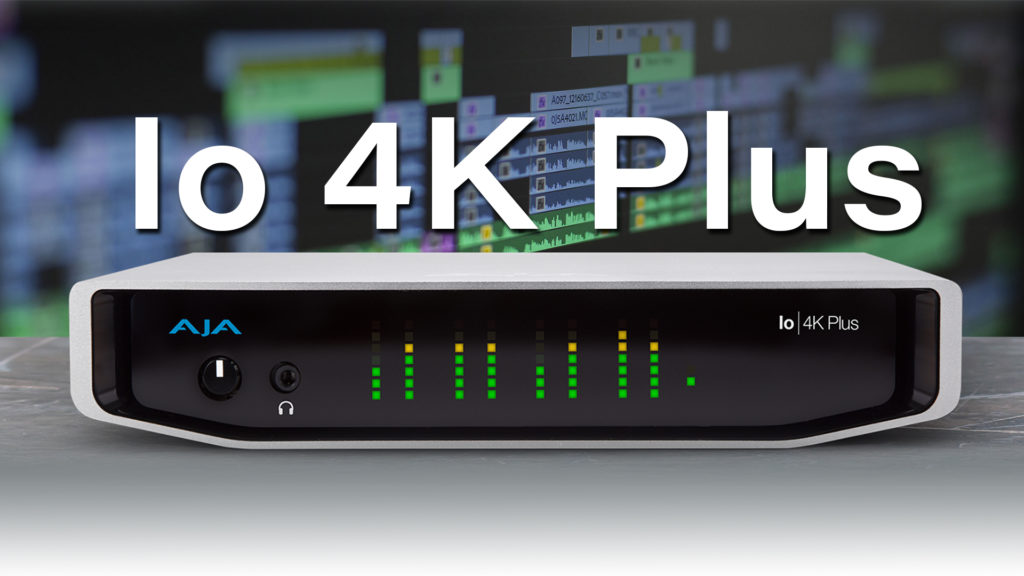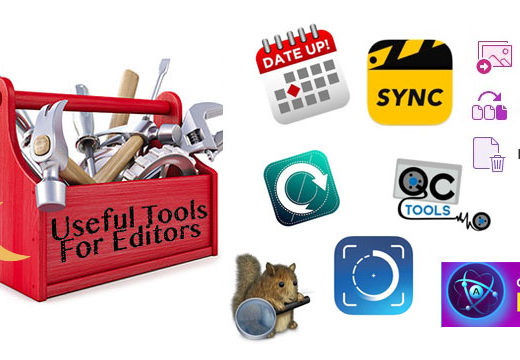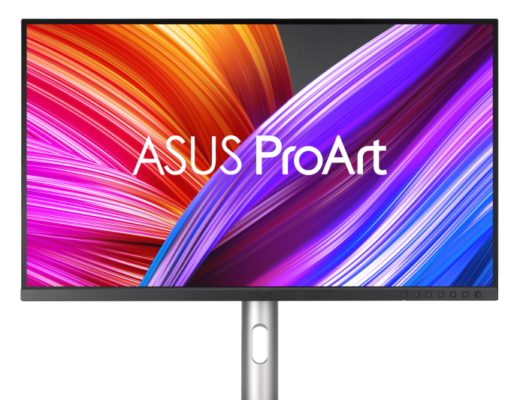It’s always tricky to find where to start when you’re beefing up your home system, so that you can tackle 4K projects in your work from home/remote setup. For me, as I’ve mentioned before, portability is important. Doesn’t matter if it’s hard drives, I/O devices or even grading panels. I want what I purchase to be perfect for both home and remote workflows, if I decide I need to work remote. Now, one thing you’ll also remember, is that I hate being told what hardware I have to use. Blackmagic, in my opinion, has made a mistake in doing this with Resolve. I can understand if you want to have that mentality for a free application. But not with one that I pay for. Now, with that being said, I’ve been an AJA user for a long time. Way back to FCS2. Yes, that’s right, Final Cut Studio 2. I’m a “KONA 3 Forever” editor, as it has easily been the single, most reliable piece of hardware I’ve ever used. That’s why I try to stick with what has been rock solid for me in the past, so when choosing an I/O device for my system, AJA was first on my list. There’s really two choices that I have for home or remote workflows. The Io 4K and the Io 4K Plus. Something that’s important to mention is that the Io 4K is coming towards it’s EOL, meaning that the Plus will take over and the standard Io 4K will no longer be sold. Keep in mind, though, if you purchased a standard 4K, you’ll still have access to AJA’s insane 3 year warranty cycle, so if there are any issues with the unit, AJA will work with you to get them fixed.
WHAT YOU GET
The Io 4K Plus is, as I mentioned earlier, an external unit, so I’m going to assume that you’re using it with a Thunderbolt 3 supported Mac or PC (supported on both OS platforms). The unit itself is fairly small. Only 222mm x 206mm x 41.9mm (WxDxH) or 8.75” x 8.1” x 1.65” (WxDxH). Yep. Less than 2” think. That’s pretty crazy. When you open the box, you get the unit, the power supply, and a sticker that is now on the side of my tower. That’s it.
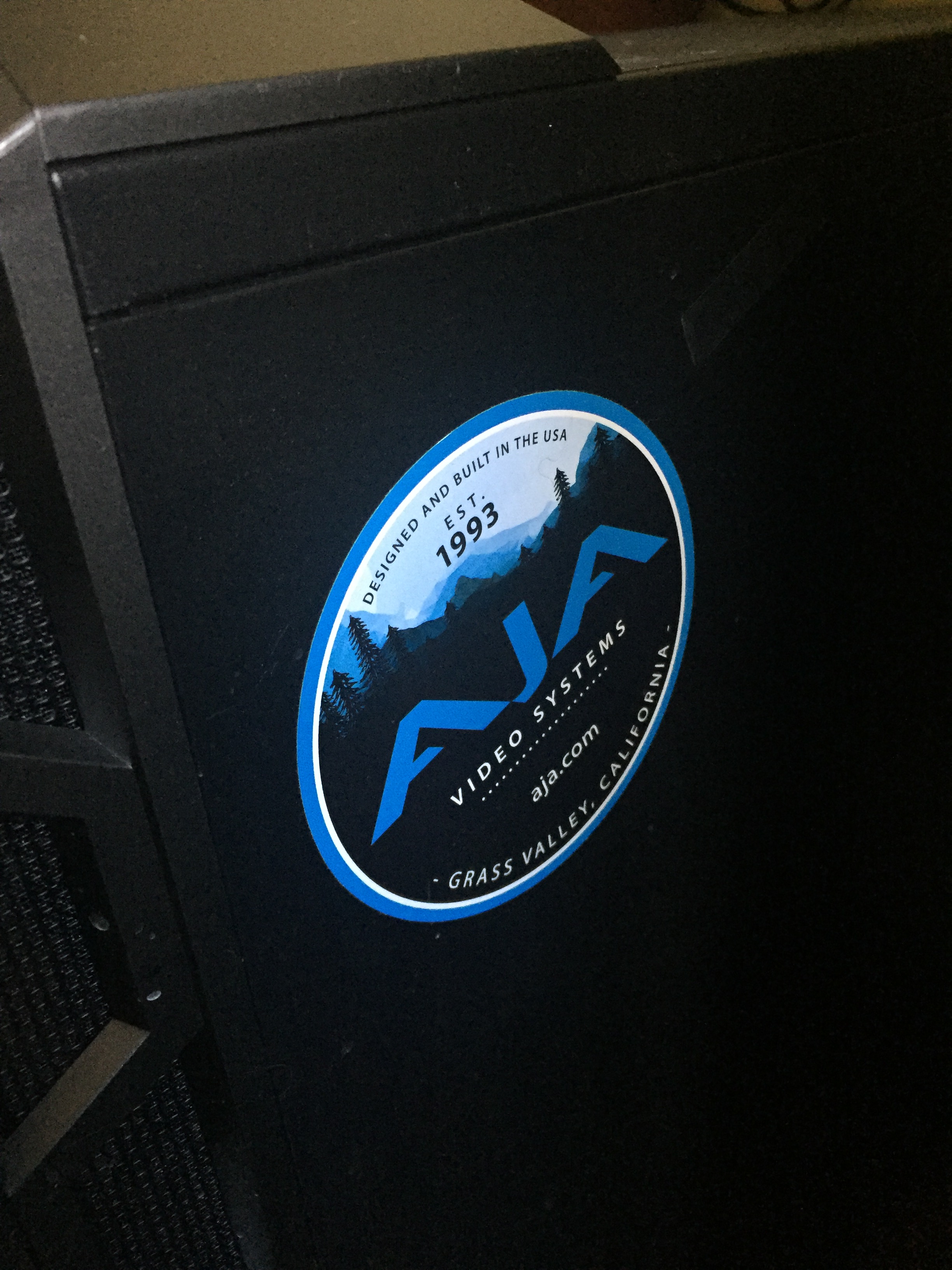
So, let’s take a look at the I/O’s to see if you’re covered for what you might need the Io 4K Plus for. First, and foremost, this is a Thunderbolt 3 device. Newer Mac and some PC users can high five for this. Older Mac users will need a Thunderbolt 2/3 adapter, and keep in mind that it says right on the website that it is backwards compatible with previous versions of Thunderbolt (we’ll go with TB2 to be sure), so if you’re rocking an older Mac, you shouldn’t have any issues running the Io 4K Plus with your “vintage” Mac. So, let’s see what else we have here

Please excuse the quality of the picture. I work in a technology driven industry, but unfortunately still have an iPhone 6S. So, let’s talk about the I/O’s you have access to:
- 4x 12G/6G/3G/1.5G-SDI bi-directional ports and HDMI 2.0 I/O for 4K, UltraHD, 2K, HD and SD with HFR support up to 60p at 4:2:2
- Real time 4K/UltraHD to 2K/HD down-conversion
- 8-,10- and 12-bit 4:2:2 and 4:4:4 over 12G-SDI or HDMI 2.0 workflow support
- Two Thunderbolt 3 ports allow easy daisy-chaining of up to six Thunderbolt devices
- 16-channel embedded audio on SDI; 8-channel embedded audio on HDMI; 4-channel analog audio in and out via XLR breakout
- Downstream keyer
- Standard 12v 4-pin XLR for AC or battery power
- RS-422 VTR control, Reference, LTC Input
- Headphone jack and level control for mobile environments
What’s also important to keep in mind is that with all the SDI connections, they are bi-directional and support 12G, 6G and 3G-SDI. 2K/HD Capture and monitoring can be simultaneous (dependant upon software) and for 4K/UHD across 12G-SDI, capture and monitoring can also be simultaneous. HOWEVER, if you’re working 4K/UHD across quad 3G-SDI, the four connections must be used for either input or output, so keep that in mind.
I want to take a second to talk about SDI integration into the Io 4K Plus, as I feel that it’s a very important feature that you should understand, so you get the most out of your unit. Now, anyone familiar with editing/post knows what SDI is. Since most of us, these days, are working with the HD standard, HD-SDI is what we’re accustomed to working with. It’s a single cable that gives you HD video, audio and timecode (Ancillary data) down one simple cable. With that said, here’s what you should know about 3G, 6G and 12G–SDI.
The updates to SDI have been to match the needs of content creators when moving from HD to 2K, 4K, 8K and higher workflows. The fact that the Io 4K Plus supports 12G-SDI means that it supports all the SDI formats from SD all the way up to 4K, and that will pretty much cover all your location editing/post needs for work you plan on doing on location for both input and output. With your 12G-SDI connection, you get 8 times the bandwidth of standard HD-SDI that you’re accustomed to working with already. With the way we’re acquiring footage these days (4K, 6K, 8K, etc), 12G-SDI can handle high frame rate and HDR over a single cable, including up to 100/120fps. 12G SDI supports 4K 60 from a single link and 8K 30 from a dual link.
For me, most of the work I would be doing is monitoring, and all the footage I’m acquiring would be via camera cards, but having the ability to plug the unit in via HDMI to a standard 4K TV (or any monitor via SDI, really), is awesome, and makes that worth the price alone!
Alright, let’s talk audio now. Up until this point, we’ve been talking about audio via SDI, which is a bit of a “set it and forget it” type of thing. Video, Audio and T/C are coming down one pipeline. If you have one signal, you have them all. However, there will inevitably be times where you will need to bring audio in from all different audio sources, locations, etc, so having flexibility is important. Taking a look at the back of the until, and reading the I/O list carefully, you will notice that there is a slot for an DB25 Audio Breakout cable.
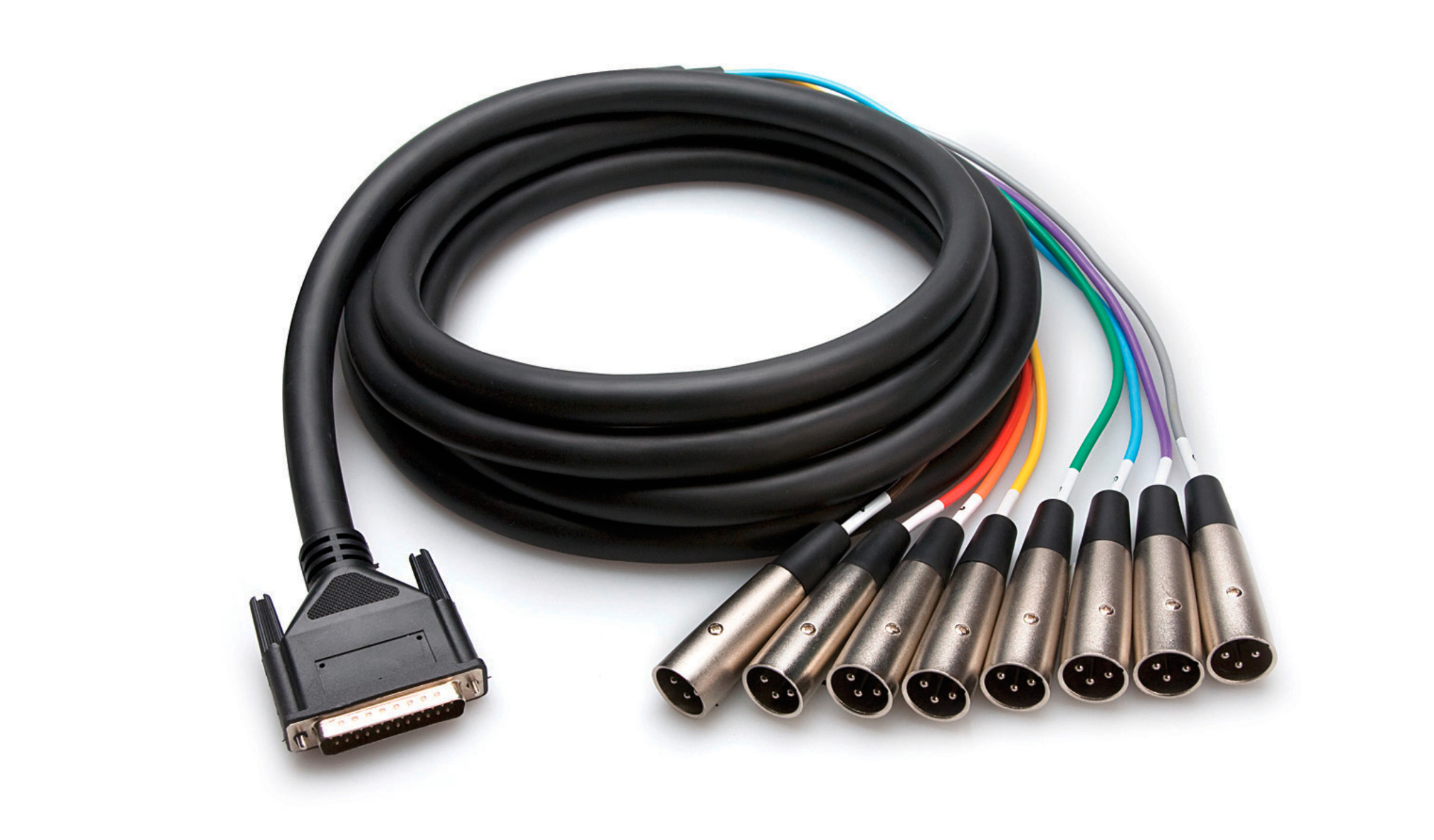
So, why is this cable not included. Well, there’s two simple reasons. First, it will raise the cost of the unit. Second, you might need a different type of audio breakout cable, based on your workflows. It’s just better for you to purchase your own, to keep your initial costs down (assuming you don’t need the cable), and to make sure you’re getting the correct breakout connection for your workflows. If at some point you decide that you need to pick up an audio breakout cable, you can pick one up from companies like HOSA (I’m not recommending, just saying that they sell the cables), and you’d be looking for a DB25 to whatever connection you need. Looking, for example, at a DB25 to XLR Female breakout cable (connector on IO4K+ to 8 separate audio cables) you’re looking at about $104 US, depending on the length you need (This example is for a 3M cable). HOSA has different resellers (Amazon, etc), so find the one you prefer, and get your cable through them.
HELLO MY FRIEND, IT’S BEEN A LONG TIME
Way back in the Final Cut Studio days, I was introduced to one of my favorite I/O tools that I’ve ever used, and that is the AJA Control Panel. Basically your hub for getting footage into and out of your system. You can see a snapshot of the AJA Control Panel below.
I also want to mention, at this point, that it is not a necessity to have a NLE (Media Composer, Final Cut Pro, Premiere) installed on your system to capture footage into your system. You do have access to the AJA Control Room (free software) that you can use for capturing, outputting and monitoring footage that you have captured, or even footage that you already have on your system. A half decent free tool that keeps you NLE independent and simplifies capture of materials to files that can be imported into an even wider range of applications (see more about it below).
Now, I want to circle back to the AJA Control Panel. My first introduction to this tool was with the KONA 3, and it’s easily the best I/O tool that has been developed for editors, DIT’s, and whoever else is using an AJA project. It works pretty simply, and if you look at it in three different sections, it’s pretty easy to figure out what’s happening.
One thing that drives me INSANE about working with a new device attached to my NLE (this is the example we’ll be working with for the rest of this review) is, when you run into an issue, trying to figure out where that issue comes in the pipeline. Is it an input issue, system issue, or output issue. You can easily spend hours trying to troubleshoot an issue that you can resolve in seconds using the AJA Control Panel.
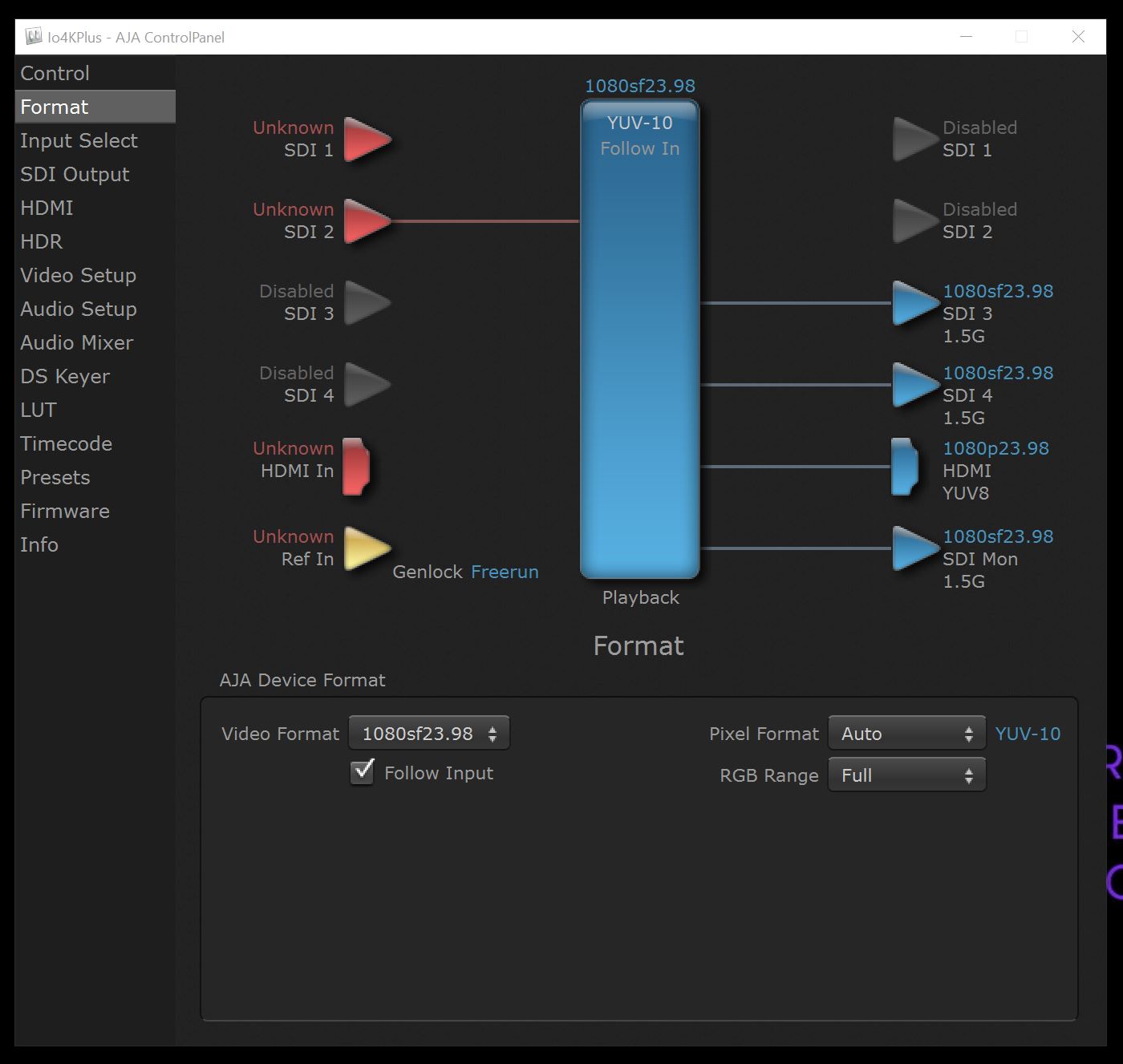
If you take a look at the diagram, it very basically represents your I/O workflow. Signal comes in, it’s processed by a system/NLE/application, and then the signal is sent out of the unit to a monitor. If you take a look at the below image, and look at the arrows down the left side of the blue bar, that represents the signal coming into the unit. If nothing appears there, there is no signal coming in.
You can see that all the left “arrows” have “Unknown” above the input name (SDI1, 2, etc). There is no single coming into the unit. So, I’m going to take a UHD signal coming down an HDMI line and plug it into the Io 4K Plus. Now take a look at what the unit does.
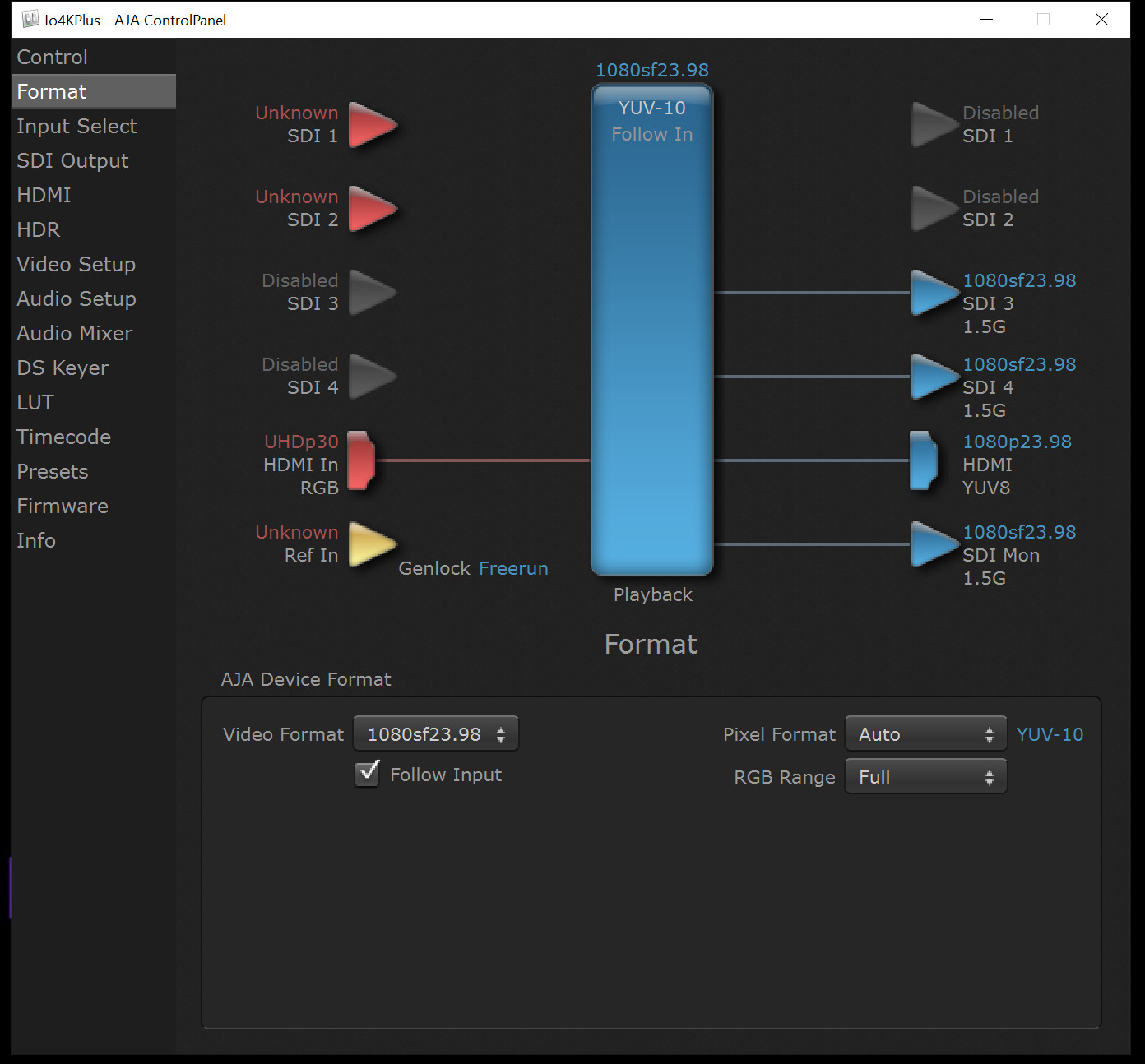
You can now see that the Io 4K Plus sees the signal coming in via HDMI, and also tells me what the signal is, which is SUPER helpful. Keep in mind that if I had a stable sync coming into the unit, I would see that as well. Now, we do have a bit of an issue going on here, that will prevent us from capturing with the Io 4K Plus. Our system, or “Playback” is currently set to 1080p, which obviously doesn’t match our input signal. We can also tell there’s an issue, because the HDMI input color is still Red. Red is bad. Blue is good. Blue is what we’re going for. Once we change the Playback format to match the input signal coming from our source, the Io 4K Plus is happy, and you can see the HDMI signal and icon are both blue.
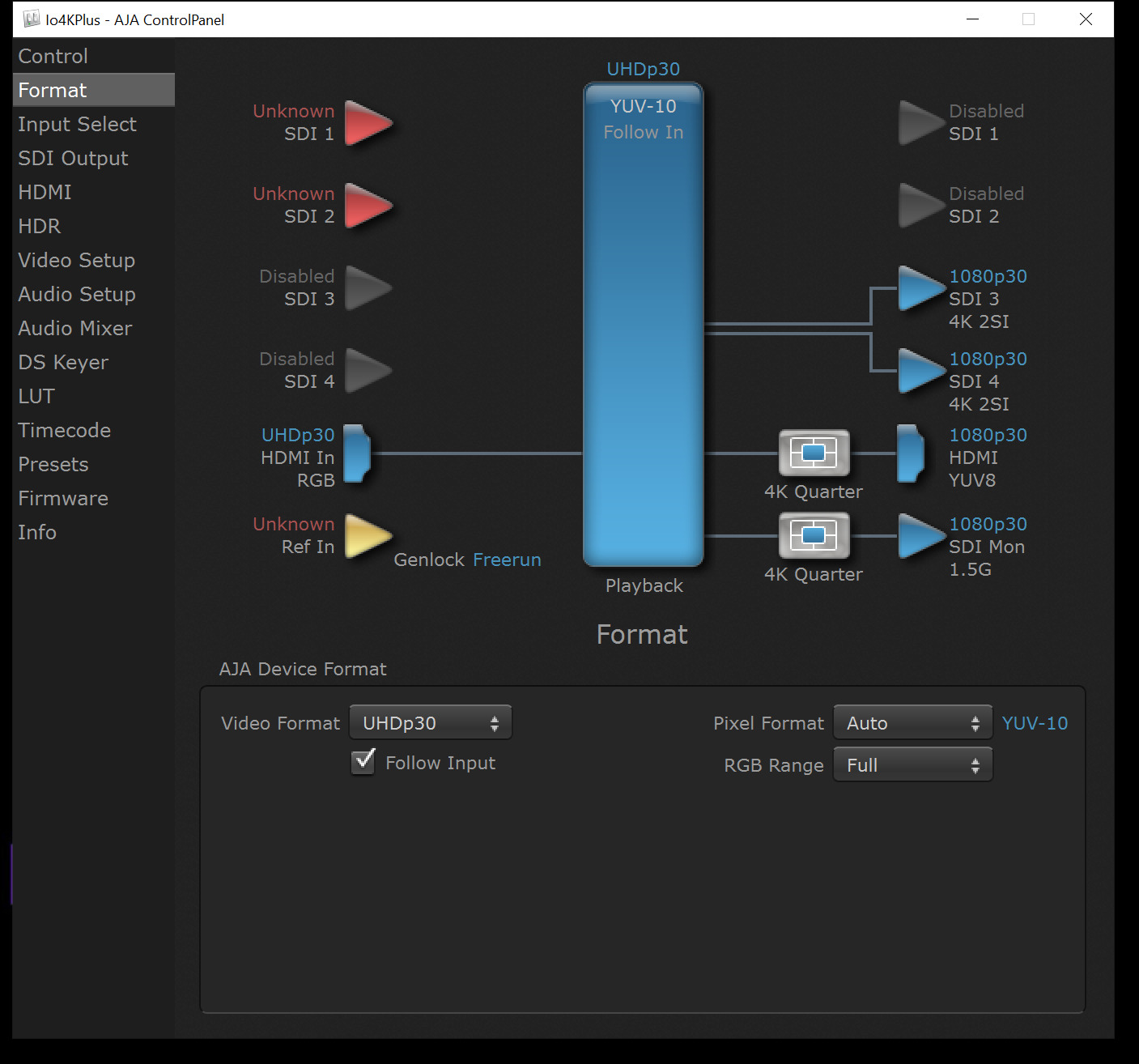
Now, depending on your output source (Monitor, Deck, etc), you can now see that once the Io 4K Plus is happy with the input and playback status, it will immediately set up monitoring/output “patches” to what it thinks you’ll want to set things to. Keep in mind that you can do real-time 4K down conversions to HD for monitoring your 4K footage on HD monitors if you want. What I also love about the AJA Control Panel is that as you click through the inputs, Playback and Outputs icons on the flow chart, the Control Panel will switch back and forth between those menu options, so you can see them immediately as you click through them.
I also want to point out that when you power the unit on, if it requires a firmware update, it will let you know immediately, so I did it when I first plugged the unit in and it was done in a couple of minutes.
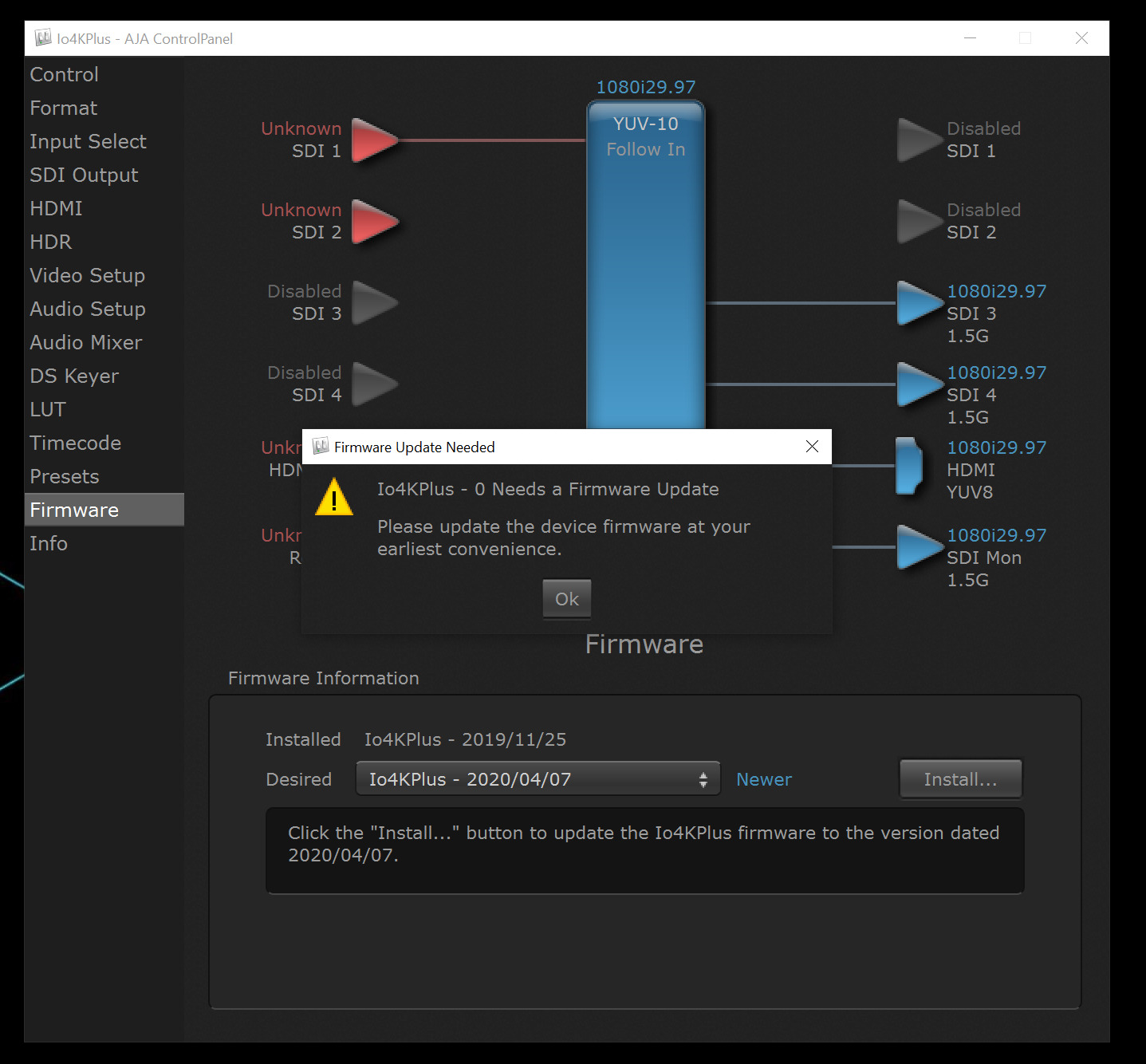
NLE INTEGRATION
Once you’ve installed the AJA Software Installer that you need to install, once you plug the unit in, these applications will be installed, alongside a range of plug-in items for software like Avid Media Composer, Adobe Premiere and more.
- AJA Control Panel v15.5.3:
- For setup and control of your AJA KONA, Io or T-TAP product, including firmware updates.
- For high quality capture, playback and output.
- AJA System Test v15.5.3:
- For testing storage to determine if it will be possible to sustain frame rates for chosen format(s).
- AJA Control Room v15.5.3:
- For high quality capture, monitoring, playback and output.
- AJA NMOS v15.5.3:
- An optional component providing discovery, registration and control for KONA IP running in SMPTE ST 2110 environments.
This will also install the drivers you need to access the Io 4K Plus in your NLE. Let’s look at Media Composer as an example. You’ll find the application, really, in two places. One is the Capture Tool. You’ll see that it’s available for you in the Capture Tool, to digitize media. You probably see from the below image that Media Composer sees the unit as a DNxIV, which is what it actually is.
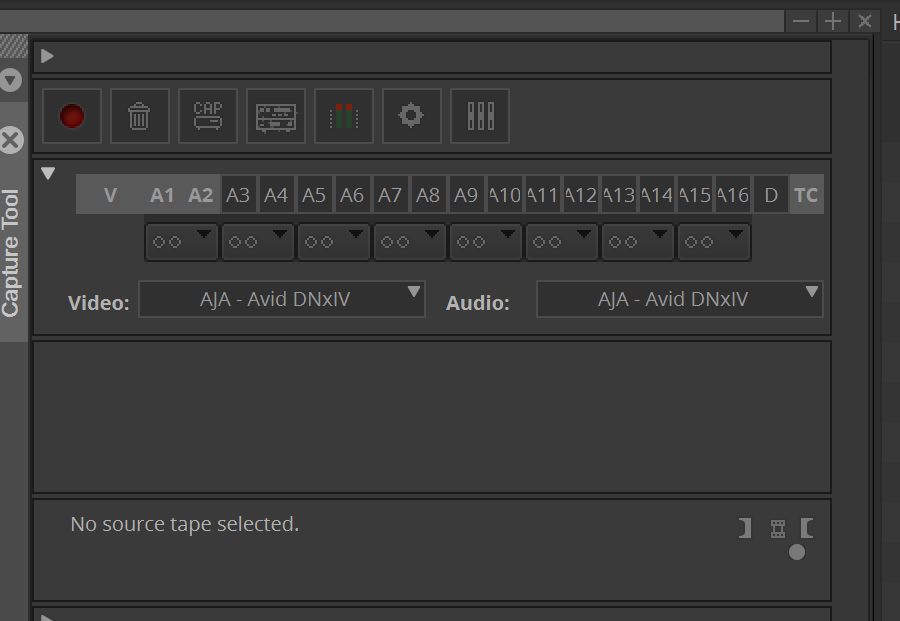
You can buy the Io 4K Plus branded as a DNxIV directly from Avid. Basically the same unit, just with an added XLR input on the front for simple VO recording needs.
If you’re not going to be using the unit to capture with, and only monitor, you can find access to the output feature, where you would normally toggle on/off external monitoring.
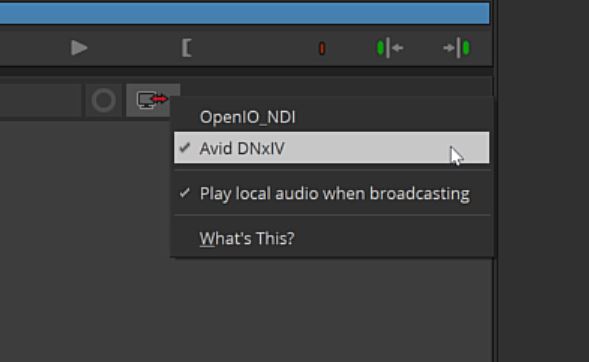
It’s actually fairly simple and straightforward, and the process will be relatively the same, no matter which NLE you’re using. HOWEVER, and this is a big HOWEVER. Something exceptionally important to keep in mind, and that is that no AJA I/O devices are supported in DaVinci Resolve. Resolve only uses Blackmagic hardware. To be honest, that’s one of the main reasons, other than it’s super awesome in general, that I use Assimilate Scratch. No issues with AJA Hardware. Works like a charm!
I did mention earlier that there is a “bundled” piece of software that comes with the Io 4K Plus , and that is the AJA Control Room. Simple to use, it’s set up for capture, playback and output, and it works much like a tape deck from an old machine room would work. Simply patch in your signal, like we were talking about earlier in the article, and capture away. This is super helpful if you’re recording VFX plates on location, and just need to capture quickly and playback to make sure you have what you need. This tool has been around forever, and hasn’t changed much, as it really doesn’t need to.
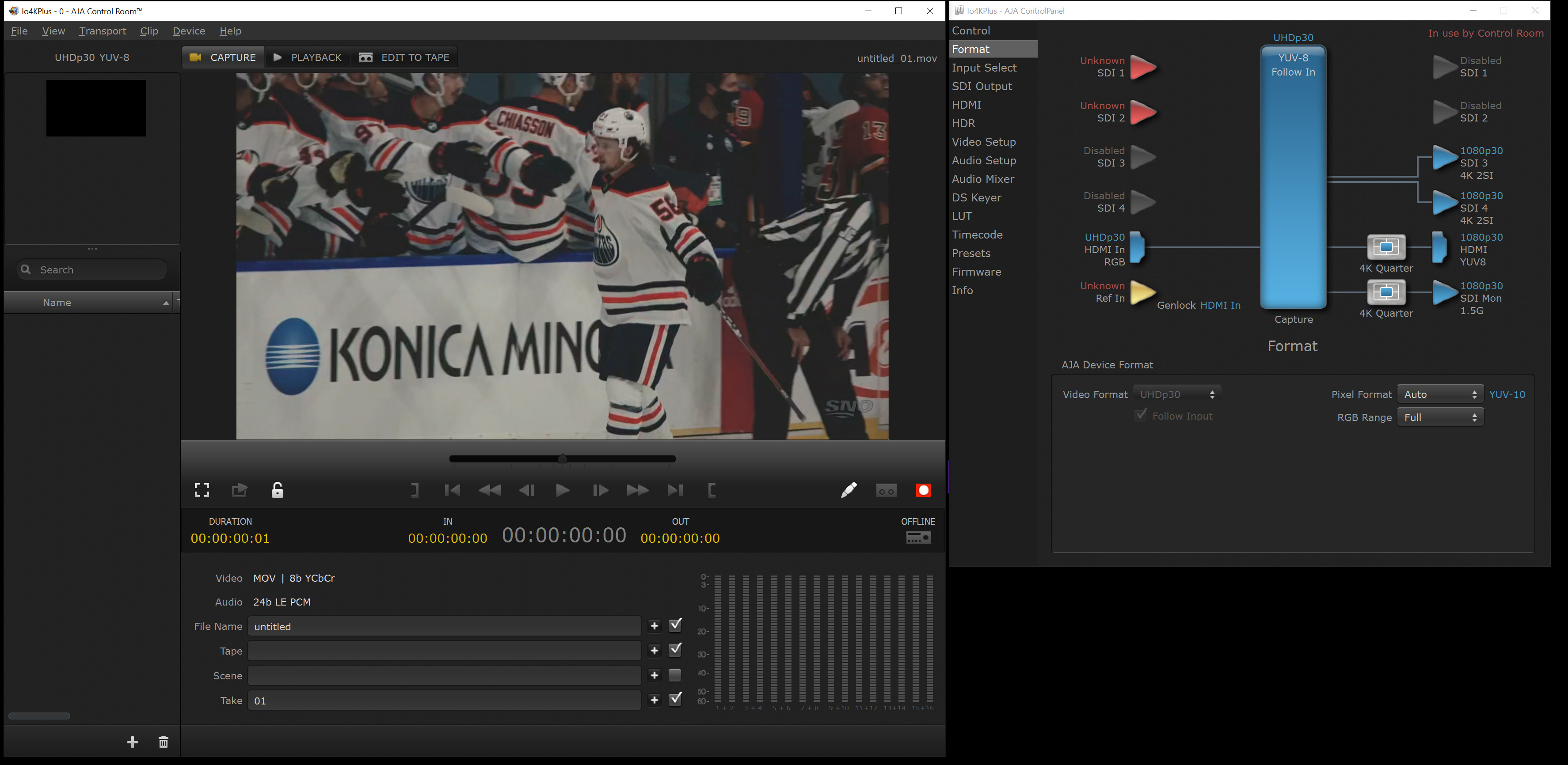
WHAT I DON’T LIKE
As great as the Io 4K Plus is, there are some really annoying things about it that I found very surprising. First, the power supply. It’s a two piece, four pin power supply. Yep, that’s right. Straight out of the gate, I’ll say that I don’t know anything about power, or power supplies, but I just got a 1000w power supply for my PC that comes with a standard “plug” power supply, which can be swapped out with any other standard power supply, which makes my life a million times easier, when I’m taking things on the road. Now, not only do I have to take this specific power supply, but it’s in two pieces, so now there’s the possibility that one of the two could go missing, and then I’m having to purchase a brand new one, as it’s different from all my other cables in my kit. The only time I’ve ever seen a power supply with a 4 pin plug is one from a battery belt.
Thinking this was a bit of an oddity, I thought I’d reach out to AJA, and ask them what the deal was with this power supply, and they put it pretty simply.
“On the power supply end, we deliberately went with an AC to DC XLR type power connection. We have a lot of clients that utilize these products on locations or sets where an AC outlet may be hard to come by. In those cases this means you can also use a battery powered source like a high end Anton Bauer battery which typically have these XLR connectors for powering cameras etc. Many documentaries especially have been produced in Africa and other locations using this kind of power in remote locations.”
So, there you go. To be honest, it’s been a super long time since I’ve used a batter belt (way back in college), and I’m not sure how much mileage you’ll get out of the battery belt to power the Io 4K Plus , but I guess it then gives the unit even more flexibility when shooting on location, which is the whole point, so that’s a good thing!
The second thing that I found is that the unit gets hot. Very hot. Hot to the point that if you touch it, you’ll be pulling your hands away pretty quick. The Io 4K Plus has a metal exterior, and no internal fan, so after having it on for about 20 minutes is where I noticed it. There’s really nothing that can be done, and since I haven’t used it for 8-10 hours of extended time, I’m not sure how much of an impact, if any, that heat is going to have on the unit, but too much heat is not a good thing.
THE CONCLUSION
Even though there are a couple of shortcomings (Heat & Power Supply issue), the Io 4K Plus itself is the tool to use if you plan on taking your 4K productions on the road, or if you’re looking for a great unit that you can use at your own location, but want the flexibility of being able to pick up and take your job remote, at a moments notice. With just about every I/O connection you could need, and the ability to work with complete I/O and monitoring inside of your NLE’s, plus its ability to work completely independent of any NLE in the AJA Control Room, this unit has all your 4K, 2K, HD and yes, even SD projects covered from capture to playback to output. The until retails for $2495 US MSRP, and you can get more information about it at this link.

Filmtools
Filmmakers go-to destination for pre-production, production & post production equipment!
Shop Now